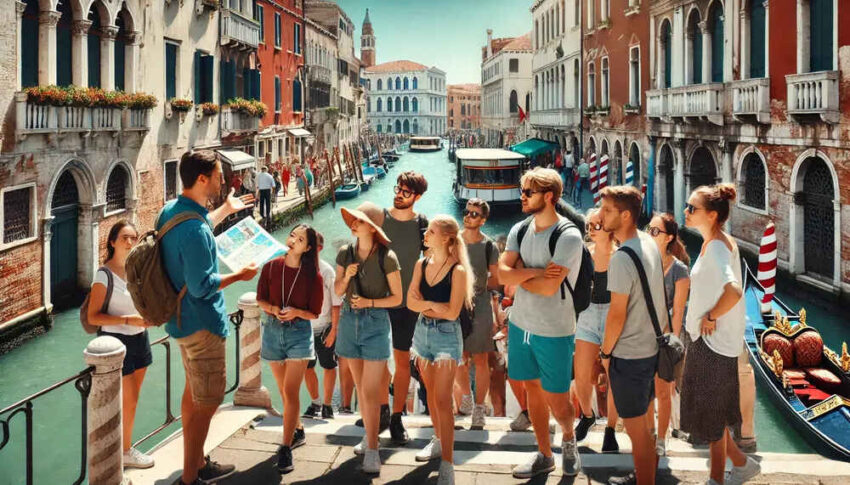Reading Time: 3 minutes
Starting Thursday, Venice will enforce a new policy limiting tourist groups to a maximum of 25 individuals as part of ongoing efforts to mitigate the impact of large crowds on the historic lagoon city. This initiative is aimed at preserving Venice’s unique charm and cultural heritage, which has been increasingly threatened by mass tourism.
In addition to group size restrictions, local authorities will prohibit tourist guides from using loudspeakers. This measure is intended to “protect the peace of residents” and ensure smoother pedestrian flow through the often congested streets and narrow alleyways of the city. The continuous noise from large tour groups and loudspeakers has long been a source of irritation for locals, and these new rules aim to provide some relief.
Non-compliance with these measures will result in fines ranging from 25 to 500 euros ($27-541). The fines are designed to enforce adherence to the new regulations and signal the seriousness of the city’s intent to manage tourism more effectively. Initially slated for implementation in June, the regulations were postponed until early August to allow for further consultation and fine-tuning.
These measures will be enforced not only in the city center but also on the surrounding islands of Murano, Burano, and Torcello. These islands, known for their unique attractions such as Murano’s glassmaking, Burano’s colorful houses, and Torcello’s historical sites, have also suffered from the pressures of overtourism. Extending the regulations to these areas aims to provide comprehensive protection across the entire Venetian lagoon.
In a pioneering move in April, Venice introduced a visitor payment system, the first of its kind globally. This system was designed to discourage daytrippers from arriving during peak times, thereby spreading out visitor numbers more evenly throughout the year. The pilot scheme, which concluded in July after 29 days, allowed city officials to gather data and assess the system’s effectiveness. It is currently under review, with authorities consulting to determine the project’s future direction based on its initial outcomes.
Several exemptions apply to the group size rule. For instance, children under two years old are excluded from the count, recognizing that families traveling with young children should not be unduly burdened. Additionally, the group size limitation is waived for student groups or those on educational tours, acknowledging the importance of educational visits and their typically more respectful and organized nature.
Venice’s initiative has garnered significant attention from other European tourist destinations facing similar challenges with overcrowding. Cities such as Barcelona, Amsterdam, and Dubrovnik are closely watching Venice’s efforts, considering similar measures to manage their own tourism pressures.
The city aims to balance tourism’s economic benefits with the need to preserve its cultural heritage and maintain the quality of life for residents. This balance is delicate, as tourism is a major economic driver for Venice, but the negative impacts of overtourism can undermine the very appeal that draws visitors in the first place.
Local businesses and tour operators are adapting to these changes, with many supporting the measures as a necessary step toward sustainable tourism. While some may face short-term challenges, there is a growing recognition that long-term sustainability is essential for the continued prosperity of Venice’s tourism industry.
Residents have expressed hope that these regulations will help reduce the strain on the city and improve their daily lives. Many locals have long felt overwhelmed by the constant influx of tourists, which often makes everyday activities difficult. By implementing these measures, the city hopes to create a more livable environment for its inhabitants.
As Venice continues to navigate the challenges of modern tourism, it serves as a model for other cities grappling with similar issues. The city’s efforts to implement innovative solutions and manage tourism sustainably could provide valuable lessons for urban centers worldwide looking to protect their cultural and historical treasures while still welcoming visitors.
The post Tourist Groups In Venice Capped At 25 People Under New Rule appeared first on Travel And Tour World.

